
I recently received an invite to head to Germany for about 24 hours before turning around and taking the first passenger flight on-board the Boeing 747-8 Intercontinental. How could I refuse?
I will be leaving Seattle (SEA) on a Lufthansa Airbus A330 non-stop to Frankfurt (FRA) before grabbing a seat on the inaugural flight from Frankfurt to Washington DC (IAD) on flight LH416. You better believe I will be sharing this experience as much as I can. Follow on Twitter and of course on the blog.
This is exciting for a number of different reasons. One of which is I have already taken a ride on one of Lufthansa’s Airbus A380s and I look forward to comparing that experience to the Intercontinental flight. It won’t be that easy, since the 747-8I is debuting Lufthansa’s new business class product, where the A380 I flew had their older product.
If you have the means (and an open calendar), I just checked this morning and there are still a few tickets left to make the inaugural flight yourself. You also have the chance to win two tickets on a future 747-8I flight on Lufthansa via their Intercontinental mini-site. Be careful though. That mini-site will make you easily burn some time with the 3D 747-8I tour, videos and more.
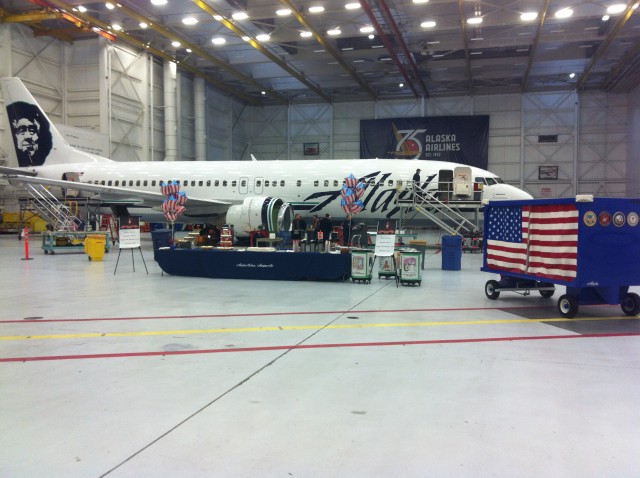
iPhone photo I was able to take of an Alaska Airlines Boeing 737 and the fallen soldier baggage cart at the airline's maintenance facility in Seattle during a special Veteran's event in November 2011.
Today is Memorial Day, where hopefully most people are able to at least take a moment and think about those who have given the ultimate sacrifice serving our country. It is a day where it shouldn’t matter if you support war or even what political party you vote for. It should be a day where we remember those men and women who have been killed while serving in the armed forces.
When a solider dies while serving, it is a delicate process to bring their body back home. There are special military protocols that airlines must follow when transporting the remains of a fallen solider, but some airlines don’t want to do the bare minimum. Each body must have a volunteer escort that follows the fallen solider from the mortuary to their final resting place.
About a year ago, Alaska Airlines technicians realized that the process of transporting a fallen solider was lacking and they looked to improve it.
“We noticed a lot of violations of military protocols due to a lack of awareness and training,” said Brian Bowden, an Alaska Airlines line aircraft technician. “Our goal is to show respect by ensuring the proper standards are followed.”
Bowden and 13 other technicians created a new “Fallen Solider” program to, “seamlessly transfer the remains of soldiers killed in action through Seattle-Tacoma International Airport.” Part of that program was creating a special baggage cart that would only be used to transport fallen soldiers. The cart was refurbished with carpet and has a retractable American flag curtain with plaques representing the Army, Navy, Air Force and Marines.
The program gives details on how to properly load and unload a soldier’s remains, as well as taking care of the escort or families. “These brave men and women sacrificed their lives for you and me,” line aircraft technician Tony Sander stated. “Often, their families are traveling alongside the fallen soldier. Mishandlings are embarrassing and unacceptable.”
Escorts will fly in the main cabin, while the fallen soldier will fly in the cargo hold. During layovers, escorts need to stay with the fallen soldier at all times and that can be challenging. Alaska has gone out of their way to provide escorts or others travelling with the remains, a working station at the airline’s maintenance facility. Airline crew will also make sure that the escort is well fed during any down time and cater to any of their other needs.
Many of the technicians who worked on the program are veterans themselves and take great pride in taking care of their own. “The technicians wanted ownership. The group has many passionate ex-military members who re-designed the process completely on their own time,” said Paul Taylor, director of line maintenance. “They took decisive action and lived up to their word.”
The program has been so successful that it has spread beyond Seattle and to other airports. “This process needs to reach all the airports we serve. Training at our other sites would spread a deeper respect for all the fallen soldiers of our armed forces,” technician Bowden said.
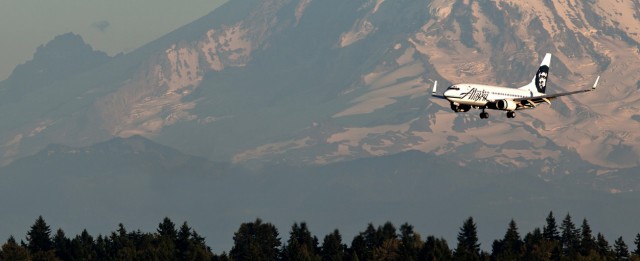
An Alaska Airlines Boeing 737 coming in for a landing. Photo by Jeremy Dwyer-Lindgren.
A big cheers to Alaska Airlines and the technicians who took the initiative to do the right thing.
On top of the Fallen Soldiers program, Alaska has a 100 person Employee Military Resource Group whose sole focus is to hire, retain and promote military employees.
Alaska has also recently started a new apprentice program, aimed directly at military experience and the transition to civilian/corporate work. Alaska proudly employees veterans who work in all capacities from maintenance to flying to the executive offices.
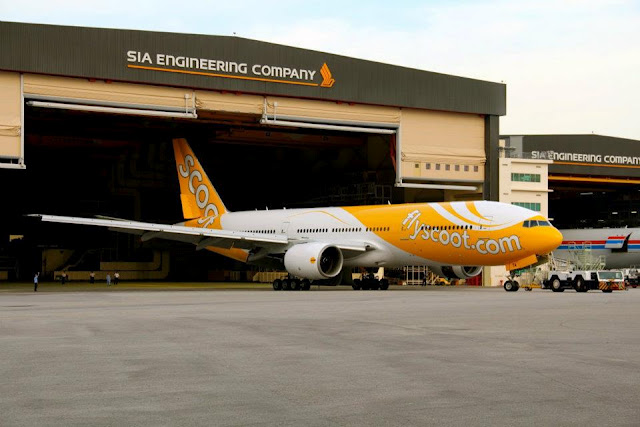
This ex-Singapore Airlines Boeing 777-200 (9V-OTA) is now painted in Scoot Airlines yellow livery. Image from Scoot.
This airline really has some Scootitude — that is their statement, not mine.
Scoot Airlines is a new low-cost airline that looks to start operations soon and is owned by parent company Singapore Airlines.
The airline currently has a fleet of two Boeing 777s, which previously flew for Singapore Airlines. The aircraft are configured in a 2-class layout with 32 ScootBiz seats in a 2-4-2 configuration and the rest in economy with a 3-4-3 configuration.
Scoot is initially planning routes from Singapore to Australia, China and Thailand. The first flight is planned for June 6, 2012 to Sydney and the rest in the following months.
This vibrant yellow livery on a Boeing 777-200 really stands out. I keep going back and forth on this one, trying to see if I like it. In some ways, I really enjoy the fact that a bright livery is on a 777, but in others, it just seems so weird, since we normally see “fun” liveries, only on smaller aircraft like the 737. What do you think?
For more images of Scoot’s livery, check out their FaceBook page.
My father, Harry Brown, helped to motivate me to fall in love with aviation. He is also a retired Naval Aviator who flew on the EA-6B. When Southwest Airlines reached out to see if I would be interested in covering a story about celebrating Armed Forces Day with a group of wounded warriors, I knew my dad would be a perfect fit. Here is his story in his own words:
In celebration of Armed Forces Day, The Palazzo/Venetian Las Vegas and Southwest Airlines joined with the Armed Forces Foundation and Omaha Steaks to salute our nation’s wounded veterans with a weekend of world-class entertainment, dining and relaxation in Las Vegas May from 16th to 19th.
I was flown to San Antonio (SAT) by Southwest Airlines to join the group of wounded warriors from the San Antonio Military Medical Facility, formally Brooke Army Medical Center, and their guests on a regularly scheduled Southwest Airlines flight to Las Vegas. The Captain of this flight worked his schedule for several days so that he was available to Captain and pilot this special occasion flight of warriors to Las Vegas.
Wednesday morning our Southwest flight departed San Antonio loaded with a very excited group of warriors anticipating their adventure that lay ahead. Prior to boarding the plane I had an opportunity to talk to several of the warriors and here are some of their comments:
– ’œIt is good to feel appreciated.’
– ’œExcited to be in Vegas for the first time. I have felt my service to my country has been appreciated.’
– ’œAwesome. Very excited to be able to go to Vegas.’
– ’œMy buddy that I got blown up with and I are going to get to visit his home town.’
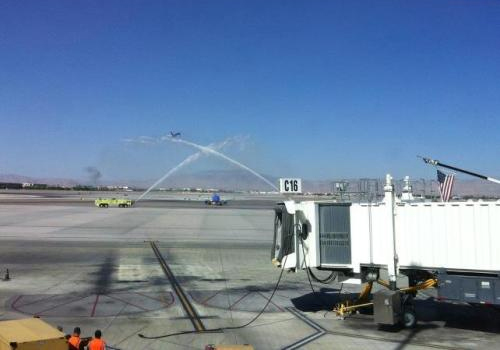
The group of Wounded Warriors received a water cannon salute when arriving at Las Vegas. Photo from Southwest Airlines.
Arriving at the McCarran International Airport (LAS) our plane was greeted with a water canon salute on the taxi into the terminal. This marked the official greeting of the wounded warriors to Las Vegas and certainly added to the festive atmosphere of the trip.
The troops departed the plane, and were greeted at the arrival gate area with hundreds of airport employees and waiting passengers from throughout the airport. The cheering support receiving line stretched from the gate area all the way to the bus loading area. No need to go to baggage claim as our bags were being retrieved and loaded on the buses for us. The bus caravan through Las Vegas to the Palazzo was quite impressive and fast as we had an eight motorcycle police escort.
Of note, the only time police escorts are provided to regulate traffic is for the Wounded Warriors or President of the United States visits.

The Venetian went patriotic to welcome the group to the hotel. Harry Brown / AirlineReporter.com.
The Palazzo/The Venetian lined the red carpet with what seemed like thousands of people, in preparation for their arrival with flags and signs expressing utmost respect for these men and women. Even gamblers who probably never went to bed dropped everything to show their respect. I don’t think there are words that can adequately explain what an amazing sight this was. The event was very emotional and heart wrenching, it brought a lump to your throat.
The grand welcome reception was held in the resort’s Waterfall & Atrium Gardens. The reception area was beautifully decorated in patriotic decoration schemes in celebration of their arrival. The welcome ceremony commenced with the Nellis Air Force Base Honor Guard presenting the colors, followed by the Pledge of Allegiance, and the National Anthem.
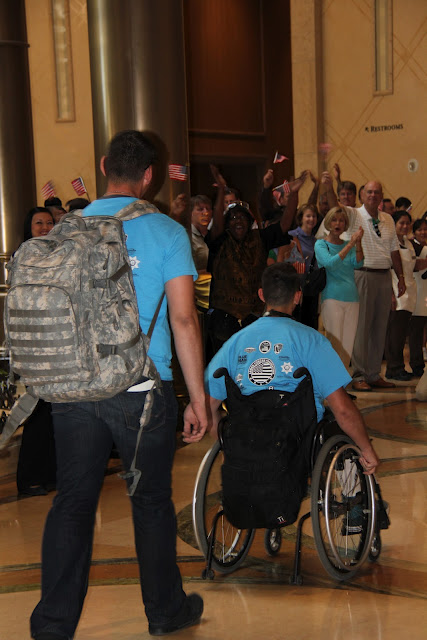
The wounded warriors were greeted by a warm welcome when arriving to the hotel. Photo by Harry Brown / AirlineReporter.com.
The MC then proceeded to introduce, in order of appearance: Linda Rutherford – Southwest Airlines representative, Bruce Simon – CEO of Omaha Steaks, Patricia Driscoll – Executive Director of the Armed Forces Foundation, and Dr. and Mrs. Sheldon Adelson CEO of Las Vegas Sands Corp (who own both hotels). Each in turn gave praise for the sacrifices all our military men and women have given for our country so that we can enjoy the liberties and freedoms we Americans enjoy today.
This is the seventh year The Sands Corp has done an event like this. Dr Adelson had visited a military medical facility seven years ago. He felt so touch/moved he sent his personal 727 to the east coast to load wounded warriors and fly them out for an all expense paid vacation to Vegas. Southwest and other companies heard about the trip and wanted to get involved and that is how we got to the event it is today.
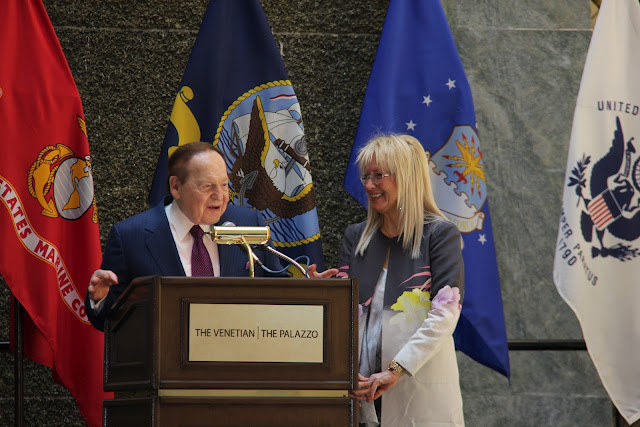
Chairman and CEO of Las Vegas Sands, Sheldon Adelson, speaks to the wounded warriors. Photo by Harry Brown / AirlineReporter.com.
Linda Rutherford, Southwest Airlines (VP of communication and strategic outreach): “We are excited to be part of this weekend that gives back to those that have given so much for our freedom and our country. We’re proud of our relationship with the Armed Forces Foundation, which supports our commitment to military service members and their families.”
Bruce Simon (Omaha Steaks CEO): “As a family-owned company with a history spanning nearly 100 years, we are humbled and grateful for the efforts of our military troops and their families, who have generously sacrificed and bravely served to protect this great nation we proudly call ‘home,'” “We are honored to be involved in this year’s ‘Salute Our Troops’ event with The Palazzo Las Vegas and Southwest Airlines to recognize these brave soldiers and their families with thanks and gratitude and to support the outstanding efforts of the Armed Forces Foundation.”
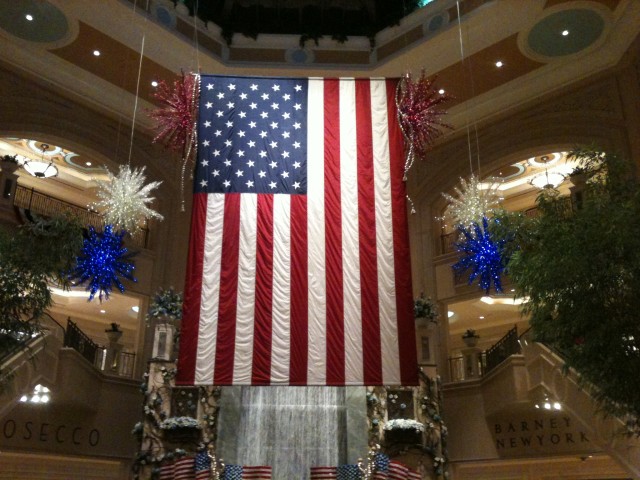
There was no shortage of red, white and blue inside the hotel. Harry Brown / AirlineReporter.com.
Patricia Driscoll (President and Executive Director of the Armed Forces Foundation): “The sacrifices our service members and their families make for our country cannot be overstated.” They rise to the occasion each and every day, so when corporations like The Palazzo Las Vegas, Southwest Airlines and Omaha Steaks unite to recognize that sacrifice by rolling out the red carpet to treat these service members to a VIP weekend in Las Vegas, that is truly special.”
Andy Abboud (Senior VP of government relations for Las Vegas Sands Corp): ’œThis festive weekend is our small way of expressing gratitude to the men and women in the Armed Forces. We recognize that they’ve sacrificed immensely for the rest of us, and we want to thank them as best we can. Honoring our veterans is a fundamental value of our chairman Sheldon Adelson and our entire company.”
In the afternoon of their first day there were multiple activities for the troops and their families to enjoy. There was a poker tournament restricted to only wounded warriors. The prize for the two top winners was two round-trip tickets from Southwest Airlines and accommodations from the Palazzo/Venetian. Five cabanas were reserved for their exclusive use pool side with drinks and food provided.
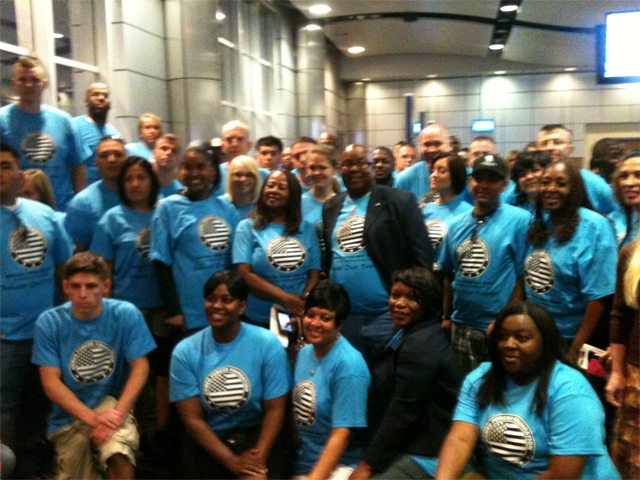
Some of the wounded warriors who were able to make the epic trip. Photo by Harry Brown / AirlineReporter.com.
In the evening a cocktail reception was followed by dinner at Lagasses’s Stadium. Talking to several of the wounded warriors during dinner that evening each told me in their own way that this is a day that they will always cherish. Each was extremely appreciative of the warm and support they had experienced throughout the day.
The following two days activities at the Palazzo were much like the first days with additional niceties added: a reserved Luxury Box at Lagasse’s Stadium, free Salon and Spa treatments at Canyon Ranch Spa, free tickets to Madame Tussauds and a Hiring Our Heroes Job Fair.
Thursday evening with warriors were treated to a cookout dinner on the Palazzo pool deck sponsored by Omaha Steaks and catered by the Venetian/Palazzo followed with free VIP tickets to TAO with a free sky box. TAO a high energy, DJ driven night club boasting a 40-foot-long outside terrace with stunning views of the Las Vegas Strip, gorgeous go-go dancers.
Friday the wounded warriors were treated to dinner at the Paiza Club. The Paiza Club is an ultra elite gambling area with its own bar and restaurant with stunning views of the city. A one million dollar credit line is required for guest to be invited to play at the Paiza Club. After dinner it was off to see a Blue Man Group performance.
Sadly, Saturday arrived and it was time to start thinking of the trip home. The send-off by the Venetian/Palazoo was just as impressive as it was for their welcome. Hundreds of Venetian/Palazzo employees and casino guests lined the way from the VIP lounge where the warriors assembled to leave to the waiting buses. Once more a police escort provided traffic control on the way to the airport. I noticed looking out the bus window that as the buses passed; the patrolmen were facing and rendering a hand salute to the passing bus caravan.
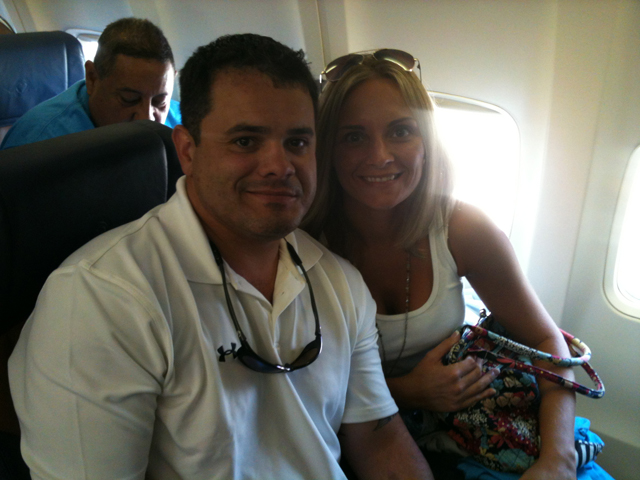
CPT Jeremy and Teresa Baggett sit on the special Southwest Flight. Harry Brown / AirlineReporter.com.
On the flight to San Antonio, this is what CPT Jeremy and Teresa Baggett USA had to say about their experience:
’œFrom start to finish, the Armed Forces Foundation, Southwest Airlines and the Adelson’s made this trip something that the Wounded Warriors and their families will never forget. The attention to detail was evident in every aspect of the trip, and no expense was spared in making the Wounded Warriors feel appreciated. From the time we arrived at the San Antonio airport to depart until we deplaned in San Antonio, the Red Carpet was rolled out.
As the warriors and their families walked through the thousands of Las Vegas Sands employees waving American Flags and screaming ’œthank you’, many of us were moved to tears. The Adelson’s have obviously fostered a sense of pride and patriotism with the employees that are often unmatched in such a large company.
No expense was spared and the level of hospitality shown to the Wounded Warriors and their families was an experience that we will never forget. Although each Wounded Warrior’s path to recovery is unique, they are all filled with struggle. This trip allowed them to relax, de-stress and rejuvenate in ways that may never be experienced again. We were treated like true ’œHigh Rollers’, and will forever be grateful for it.
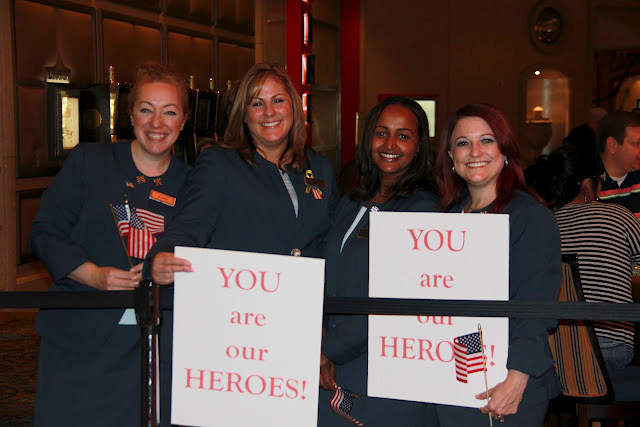
Staff of the Palazzo hotel welcome the wounded warriors. Harry Brown / AirlineReporter.com.
These men and women are phenomenal human beings, and as humble as they come. Spending time among these Wounded Warriors, and their guests has really encouraged me to take a step back and reflect on what truly matters, and using the hand you have been dealt to its fullest capabilities.
Southwest Airlines has a long history of supporting the men and women who fight for our Freedoms. They were named one of G.I. Jobs Top 100 Military Friendly Employers for 2010. Southwest Airlines also was recognized by the Employer Support of the Guard and Reserve (ESGR) for their commitment and support of our National Guard and Reserve Employees. Southwest is one of the most honored airlines in the world known for its commitment to the triple bottom line of Performance, People, and Planet. I’d like to add a fourth ’“ Patriotism.











